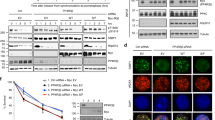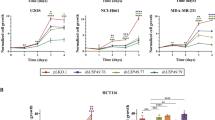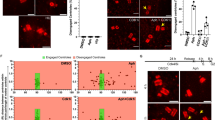Abstract
Although 53BP1 has been established well as a mediator in DNA damage response, its function in mitosis is not clearly understood. We found that 53BP1 is a mitotic-binding partner of the kinases Plk1 and AuroraA, and that the binding with Plk1 increases the stability of 53BP1 by accelerating its interaction with the deubiquitinase USP7. Depletion of 53BP1 induces mitotic defects such as chromosomal missegregation, misorientation of spindle poles and the generation of extra centrosomes, which is similar phenotype to USP7-knockdown cells. In addition, 53BP1 depletion reduces the levels of p53 and centromere protein F (CENPF), interacting proteins of 53BP1. These phenotypes induced by 53BP1 depletion were rescued by expression of wild-type or phosphomimic mutant 53BP1 but not by expression of a dephosphomimic mutant. We propose that phosphorylation of 53BP1 at S380 accelerates complex formation with USP7 and CENPF to regulate their stability, thus having a crucial role in proper centrosome positioning, chromosomal alignment, and centrosome number.
This is a preview of subscription content, access via your institution
Access options
Subscribe to this journal
Receive 50 print issues and online access
$259.00 per year
only $5.18 per issue
Buy this article
- Purchase on Springer Link
- Instant access to full article PDF
Prices may be subject to local taxes which are calculated during checkout







Similar content being viewed by others
References
Iwabuchi K, Bartel PL, Li B, Marraccino R, Fields S . Two cellular proteins that bind to wild-type but not mutant p53. Proc Natl Acad Sci USA 1994; 91: 6098–6102.
Wang B, Matsuoka S, Carpenter PB, Elledge SJ . 53BP1, a mediator of the DNA damage checkpoint. Science 2002; 298: 1435–1438.
Morales JC, Xia Z, Lu T, Aldrich MB, Wang B, Rosales C et al. Role for the BRCA1 C-terminal repeats (BRCT) protein 53BP1 in maintaining genomic stability. J Biol Chem 2003; 278: 14971–14977.
Liu J, Pan Y, Ma B, Nussinov R . "Similarity trap" in protein-protein interactions could be carcinogenic: simulations of p53 core domain complexed with 53BP1 and BRCA1 BRCT domains. Structure 2006; 14: 1811–1821.
Iwabuchi K, Li B, Massa HF, Trask BJ, Date T, Fields S . Stimulation of p53-mediated transcriptional activation by the p53-binding proteins, 53BP1 and 53BP2. J Biol Chem 1998; 273: 26061–26068.
Anderson L, Henderson C, Adachi Y . Phosphorylation and rapid relocalization of 53BP1 to nuclear foci upon DNA damage. Mol Cell Biol 2001; 21: 1719–1729.
Rappold I, Iwabuchi K, Date T, Chen J . Tumor suppressor p53 binding protein 1 (53BP1) is involved in DNA damage-signaling pathways. J Cell Biol 2001; 153: 613–620.
Fradet-Turcotte A, Canny MD, Escribano-Diaz C, Orthwein A, Leung CC, Huang H et al. 53BP1 is a reader of the DNA-damage-induced H2A Lys 15 ubiquitin mark. Nature 2013; 499: 50–54.
Scully R, Xie A . Double strand break repair functions of histone H2AX. Mutat Res 2013; 750: 5–14.
Fernandez-Capetillo O, Chen HT, Celeste A, Ward I, Romanienko PJ, Morales JC et al. DNA damage-induced G2-M checkpoint activation by histone H2AX and 53BP1. Nat Cell Biol 2002; 4: 993–997.
van Vugt MA, Gardino AK, Linding R, Ostheimer GJ, Reinhardt HC, Ong SE et al. A mitotic phosphorylation feedback network connects Cdk1, Plk1, 53BP1, and Chk2 to inactivate the G(2)/M DNA damage checkpoint. PLoS Biol 2010; 8: e1000287.
Jullien D, Vagnarelli P, Earnshaw WC, Adachi Y . Kinetochore localisation of the DNA damage response component 53BP1 during mitosis. J Cell Sci 2002; 115: 71–79.
Kwak HJ, Kim SH, Yoo HG, Park SH, Lee CH . Jun activation domain-binding protein 1 is required for mitotic checkpoint activation via its involvement in hyperphosphorylation of 53BP1. J Cancer Res Clin Oncol 2005; 131: 789–796.
Nelson G, Buhmann M, von Zglinicki T . DNA damage foci in mitosis are devoid of 53BP1. Cell Cycle 2009; 8: 3379–3383.
Giunta S, Belotserkovskaya R, Jackson SP . DNA damage signaling in response to double-strand breaks during mitosis. J Cell Biol 2010; 190: 197–207.
Orthwein A, Fradet-Turcotte A, Noordermeer SM, Canny MD, Brun CM, Strecker J et al. Mitosis inhibits DNA double-strand break repair to guard against telomere fusions. Science 2014; 344: 189–193.
Benada J, Burdova K, Lidak T, von Morgen P, Macurek L . Polo-like kinase 1 inhibits DNA damage response during mitosis. Cell Cycle 2015; 14: 219–231.
Yim H, Erikson RL . Plk1-targeted therapies in TP53- or RAS-mutated cancer. Mutat Res 2014; 761: 31–39.
Lee KS, Grenfell TZ, Yarm FR, Erikson RL . Mutation of the polo-box disrupts localization and mitotic functions of the mammalian polo kinase Plk. Proc Natl Acad Sci USA 1998; 95: 9301–9306.
Elia AE, Cantley LC, Yaffe MB . Proteomic screen finds pSer/pThr-binding domain localizing Plk1 to mitotic substrates. Science 2003; 299: 1228–1231.
Elia AE, Rellos P, Haire LF, Chao JW, Ivins FJ, Hoepker K et al. The molecular basis for phosphodependent substrate targeting and regulation of Plks by the Polo-box domain. Cell 2003; 115: 83–95.
Kishi K, van Vugt MA, Okamoto K, Hayashi Y, Yaffe MB . Functional dynamics of Polo-like kinase 1 at the centrosome. Mol Cell Biol 2009; 29: 3134–3150.
Golsteyn RM, Schultz SJ, Bartek J, Ziemiecki A, Ried T, Nigg EA . Cell cycle analysis and chromosomal localization of human Plk1, a putative homologue of the mitotic kinases Drosophila polo and Saccharomyces cerevisiae Cdc5. J Cell Sci 1994; 107: 1509–1517.
Barr FA, Sillje HH, Nigg EA . Polo-like kinases and the orchestration of cell division. Nat Rev Mol Cell Biol 2004; 5: 429–440.
Sumara I, Gimenez-Abian JF, Gerlich D, Hirota T, Kraft C, de la Torre C et al. Roles of polo-like kinase 1 in the assembly of functional mitotic spindles. Curr Biol 2004; 14: 1712–1722.
Ahonen LJ, Kallio MJ, Daum JR, Bolton M, Manke IA, Yaffe MB et al. Polo-like kinase 1 creates the tension-sensing 3F3/2 phosphoepitope and modulates the association of spindle-checkpoint proteins at kinetochores. Curr Biol 2005; 15: 1078–1089.
Brennan IM, Peters U, Kapoor TM, Straight AF . Polo-like kinase controls vertebrate spindle elongation and cytokinesis. PloS One 2007; 2: e409.
Elowe S, Hummer S, Uldschmid A, Li X, Nigg EA . Tension-sensitive Plk1 phosphorylation on BubR1 regulates the stability of kinetochore microtubule interactions. Genes Dev 2007; 21: 2205–2219.
Kang YH, Park CH, Kim TS, Soung NK, Bang JK, Kim BY et al. Mammalian polo-like kinase 1-dependent regulation of the PBIP1-CENP-Q complex at kinetochores. J Biol Chem 2011; 286: 19744–19757.
Yim H, Erikson RL . Polo-like kinase 1 depletion induces DNA damage in early S prior to caspase activation. Mol Cell Biol 2009; 29: 2609–2621.
Yoo E, Kim BU, Lee SY, Cho CH, Chung JH, Lee CH . 53BP1 is associated with replication protein A and is required for RPA2 hyperphosphorylation following DNA damage. Oncogene 2005; 24: 5423–5430.
Eliezer Y, Argaman L, Rhie A, Doherty AJ, Goldberg M . The direct interaction between 53BP1 and MDC1 is required for the recruitment of 53BP1 to sites of damage. J Biol Chem 2009; 284: 426–435.
Zhang D, Zaugg K, Mak TW, Elledge SJ . A role for the deubiquitinating enzyme USP28 in control of the DNA-damage response. Cell 2006; 126: 529–542.
Jang YJ, Lin CY, Ma S, Erikson RL . Functional studies on the role of the C-terminal domain of mammalian polo-like kinase. Proc Natl Acad Sci USA 2002; 99: 1984–1989.
Eletr ZM, Wilkinson KD . Regulation of proteolysis by human deubiquitinating enzymes. Biochim Biophys Acta 2014; 1843: 114–128.
Nigg EA . Centrosome duplication: of rules and licenses. Trends Cell Biol 2007; 17: 215–221.
Ganem NJ, Godinho SA, Pellman D . A mechanism linking extra centrosomes to chromosomal instability. Nature 2009; 460: 278–282.
Habedanck R, Stierhof YD, Wilkinson CJ, Nigg EA . The Polo kinase Plk4 functions in centriole duplication. Nat Cell Biol 2005; 7: 1140–1146.
Holt SV, Vergnolle MA, Hussein D, Wozniak MJ, Allan VJ, Taylor SS . Silencing Cenp-F weakens centromeric cohesion, prevents chromosome alignment and activates the spindle checkpoint. J Cell Sci 2005; 118: 4889–4900.
Bomont P, Maddox P, Shah JV, Desai AB, Cleveland DW . Unstable microtubule capture at kinetochores depleted of the centromere-associated protein CENP-F. EMBO J 2005; 24: 3927–3939.
Vergnolle MA, Taylor SS . Cenp-F links kinetochores to Ndel1/Nde1/Lis1/dynein microtubule motor complexes. Curr Biol 2007; 17: 1173–1179.
Moynihan KL, Pooley R, Miller PM, Kaverina I, Bader DM . Murine CENP-F regulates centrosomal microtubule nucleation and interacts with Hook2 at the centrosome. Mol Biol Cell 2009; 20: 4790–4803.
Nigg EA, Raff JW . Centrioles, centrosomes, and cilia in health and disease. Cell 2009; 139: 663–678.
Fukasawa K, Choi T, Kuriyama R, Rulong S, Vande Woude GF . Abnormal centrosome amplification in the absence of p53. Science 1996; 271: 1744–1747.
Sankaran S, Starita LM, Groen AC, Ko MJ, Parvin JD . Centrosomal microtubule nucleation activity is inhibited by BRCA1-dependent ubiquitination. Mol Cell Biol 2005; 25: 8656–8668.
Izumi H, Matsumoto Y, Ikeuchi T, Saya H, Kajii T, Matsuura S . BubR1 localizes to centrosomes and suppresses centrosome amplification via regulating Plk1 activity in interphase cells. Oncogene 2009; 28: 2806–2820.
Ward IM, Difilippantonio S, Minn K, Mueller MD, Molina JR, Yu X et al. 53BP1 cooperates with p53 and functions as a haploinsufficient tumor suppressor in mice. Mol Cell Biol 2005; 25: 10079–10086.
Morales JC, Franco S, Murphy MM, Bassing CH, Mills KD, Adams MM et al. 53BP1 and p53 synergize to suppress genomic instability and lymphomagenesis. Proc Natl Acad Sci USA 2006; 103: 3310–3315.
Bolhy S, Bouhlel I, Dultz E, Nayak T, Zuccolo M, Gatti X et al. A Nup133-dependent NPC-anchored network tethers centrosomes to the nuclear envelope in prophase. J Cell Biol 2011; 192: 855–871.
Basto R, Brunk K, Vinadogrova T, Peel N, Franz A, Khodjakov A et al. Centrosome amplification can initiate tumorigenesis in flies. Cell 2008; 133: 1032–1042.
Li J, Tan M, Li L, Pamarthy D, Lawrence TS, Sun Y . SAK, a new polo-like kinase, is transcriptionally repressed by p53 and induces apoptosis upon RNAi silencing. Neoplasia 2005; 7: 312–323.
Nakamura T, Saito H, Takekawa M . SAPK pathways and p53 cooperatively regulate PLK4 activity and centrosome integrity under stress. Nat Commun 2013; 4: 1775.
Varis A, Salmela AL, Kallio MJ . Cenp-F (mitosin) is more than a mitotic marker. Chromosoma 2006; 115: 288–295.
Yang Z, Guo J, Chen Q, Ding C, Du J, Zhu X . Silencing mitosin induces misaligned chromosomes, premature chromosome decondensation before anaphase onset, and mitotic cell death. Mol Cell Biol 2005; 25: 4062–4074.
Gurden MD, Holland AJ, van Zon W, Tighe A, Vergnolle MA, Andres DA et al. Cdc20 is required for the post-anaphase, KEN-dependent degradation of centromere protein F. J Cell Sci 2010; 123: 321–330.
Liu X, Lei M, Erikson RL . Normal cells, but not cancer cells, survive severe Plk1 depletion. Mol Cell Biol 2006; 26: 2093–2108.
Dietzmann K, Kirches E, von B, Jachau K, Mawrin C . Increased human polo-like kinase-1 expression in gliomas. J Neurooncol 2001; 53: 1–11.
Acknowledgements
We thank Dr Phillip B Carpenter (University of Texas Health Sciences Center, TX, USA), Dr Stephen J Elledge (Harvard University, MA, USA), Dr Daniel Durocher (University of Toronto, Canada) and Dr Anindya Dutta (University of Virginia School of Medicine, VA, USA) for generously providing plasmids for HA-53BP1, GFP-53BP1 and USP7, respectively. We thank Dr Jeong-Ho Hong (Korea University, Korea), Dr Mi-Ran Byun, Mi Kyung Sung and Hay Ran Jang (Hanyang University, Korea) for technical assistance. This work was supported by the Basic Science Research Program through the National Research Foundation of Korea (NRF) funded by the Ministry of Education, Science and Technology (NRF-2012R1A2A2A06044458; NRF-2014R1A2A1A11049701) to HY.
Author information
Authors and Affiliations
Corresponding author
Ethics declarations
Competing interests
The authors declare no conflict of interest.
Additional information
Supplementary Information accompanies this paper on the Oncogene website
Supplementary information
Rights and permissions
About this article
Cite this article
Yim, H., Shin, SB., Woo, S. et al. Plk1-mediated stabilization of 53BP1 through USP7 regulates centrosome positioning to maintain bipolarity. Oncogene 36, 966–978 (2017). https://doi.org/10.1038/onc.2016.263
Received:
Revised:
Accepted:
Published:
Issue Date:
DOI: https://doi.org/10.1038/onc.2016.263
This article is cited by
-
Formation of memory assemblies through the DNA-sensing TLR9 pathway
Nature (2024)
-
PLK1/vimentin signaling facilitates immune escape by recruiting Smad2/3 to PD-L1 promoter in metastatic lung adenocarcinoma
Cell Death & Differentiation (2021)
-
Protein deubiquitinase USP7 is required for osteogenic differentiation of human adipose-derived stem cells
Stem Cell Research & Therapy (2017)



